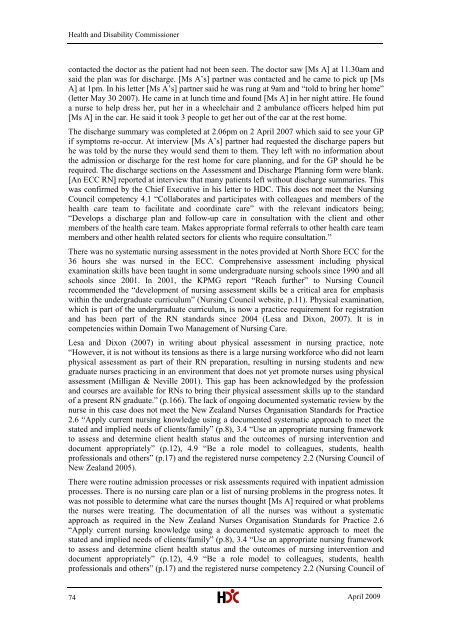North Shore Hospital report - New Zealand Doctor
North Shore Hospital report - New Zealand Doctor
North Shore Hospital report - New Zealand Doctor
Create successful ePaper yourself
Turn your PDF publications into a flip-book with our unique Google optimized e-Paper software.
Health and Disability Commissionercontacted the doctor as the patient had not been seen. The doctor saw [Ms A] at 11.30am andsaid the plan was for discharge. [Ms A‘s] partner was contacted and he came to pick up [MsA] at 1pm. In his letter [Ms A‘s] partner said he was rung at 9am and ―told to bring her home‖(letter May 30 2007). He came in at lunch time and found [Ms A] in her night attire. He founda nurse to help dress her, put her in a wheelchair and 2 ambulance officers helped him put[Ms A] in the car. He said it took 3 people to get her out of the car at the rest home.The discharge summary was completed at 2.06pm on 2 April 2007 which said to see your GPif symptoms re-occur. At interview [Ms A‘s] partner had requested the discharge papers buthe was told by the nurse they would send them to them. They left with no information aboutthe admission or discharge for the rest home for care planning, and for the GP should he berequired. The discharge sections on the Assessment and Discharge Planning form were blank.[An ECC RN] <strong>report</strong>ed at interview that many patients left without discharge summaries. Thiswas confirmed by the Chief Executive in his letter to HDC. This does not meet the NursingCouncil competency 4.1 ―Collaborates and participates with colleagues and members of thehealth care team to facilitate and coordinate care‖ with the relevant indicators being;―Develops a discharge plan and follow-up care in consultation with the client and othermembers of the health care team. Makes appropriate formal referrals to other health care teammembers and other health related sectors for clients who require consultation.‖There was no systematic nursing assessment in the notes provided at <strong>North</strong> <strong>Shore</strong> ECC for the36 hours she was nursed in the ECC. Comprehensive assessment including physicalexamination skills have been taught in some undergraduate nursing schools since 1990 and allschools since 2001. In 2001, the KPMG <strong>report</strong> ―Reach further‖ to Nursing Councilrecommended the ―development of nursing assessment skills be a critical area for emphasiswithin the undergraduate curriculum‖ (Nursing Council website, p.11). Physical examination,which is part of the undergraduate curriculum, is now a practice requirement for registrationand has been part of the RN standards since 2004 (Lesa and Dixon, 2007). It is incompetencies within Domain Two Management of Nursing Care.Lesa and Dixon (2007) in writing about physical assessment in nursing practice, note―However, it is not without its tensions as there is a large nursing workforce who did not learnphysical assessment as part of their RN preparation, resulting in nursing students and newgraduate nurses practicing in an environment that does not yet promote nurses using physicalassessment (Milligan & Neville 2001). This gap has been acknowledged by the professionand courses are available for RNs to bring their physical assessment skills up to the standardof a present RN graduate.‖ (p.166). The lack of ongoing documented systematic review by thenurse in this case does not meet the <strong>New</strong> <strong>Zealand</strong> Nurses Organisation Standards for Practice2.6 ―Apply current nursing knowledge using a documented systematic approach to meet thestated and implied needs of clients/family‖ (p.8), 3.4 ―Use an appropriate nursing frameworkto assess and determine client health status and the outcomes of nursing intervention anddocument appropriately‖ (p.12), 4.9 ―Be a role model to colleagues, students, healthprofessionals and others‖ (p.17) and the registered nurse competency 2.2 (Nursing Council of<strong>New</strong> <strong>Zealand</strong> 2005).There were routine admission processes or risk assessments required with inpatient admissionprocesses. There is no nursing care plan or a list of nursing problems in the progress notes. Itwas not possible to determine what care the nurses thought [Ms A] required or what problemsthe nurses were treating. The documentation of all the nurses was without a systematicapproach as required in the <strong>New</strong> <strong>Zealand</strong> Nurses Organisation Standards for Practice 2.6―Apply current nursing knowledge using a documented systematic approach to meet thestated and implied needs of clients/family‖ (p.8), 3.4 ―Use an appropriate nursing frameworkto assess and determine client health status and the outcomes of nursing intervention anddocument appropriately‖ (p.12), 4.9 ―Be a role model to colleagues, students, healthprofessionals and others‖ (p.17) and the registered nurse competency 2.2 (Nursing Council of74April 2009
















